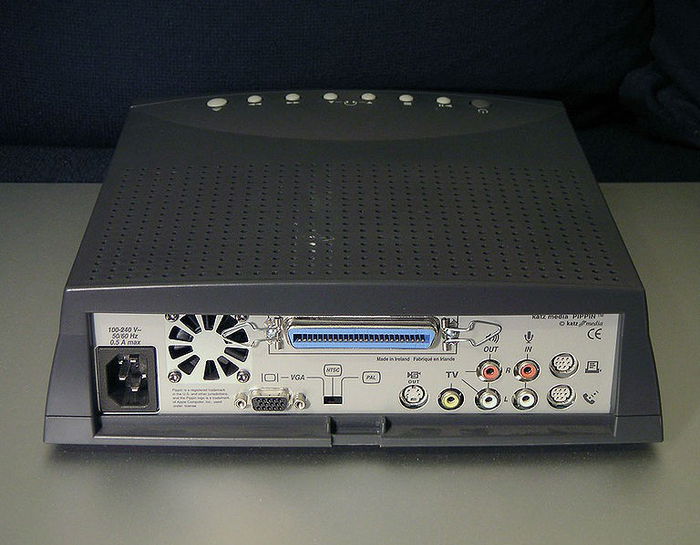In the mid-1990s, Apple was going through a turbulent period with declining market share in the personal computer market, increasing competition, and a need to diversify its operations. It was in this context that the Apple Pippin console project (stylized “Pipp!n”) emerged, a platform that positioned itself between a video game console, a microcomputer, and a multimedia television device.
Apple didn't want to simply be another console manufacturer like Sony or Sega; its business model involved licensing hardware and software technology to third parties, such as the Japanese company Bandai, to manufacture and market regional versions. Despite good intentions and bold ideas like a 4x CD-ROM drive, built-in modem, Mac OS-based system, cross-region title compatibility, and modular expansion, the Pippin ended up being one of the biggest stumbles in console history: very low sales, an almost nonexistent game library, confusing positioning, and very high prices.
In this article, we’ll explore the entire history of the Pippin: from the conception of the idea, through technical developments, launch, versions, software, market failures, and finally the project's closure, as well as reflecting on why it failed so clearly, and what legacy (or lesson) it left behind.


Concept and Origin
The concept of the Apple Pippin began in the early 1990s, when Apple saw several signs of change in the computer and consumer electronics market: the popularization of CD-ROMs, the pressure for lower prices on personal computers, and the vision that the "living room computer" could become a reality. Apple then decided to develop a media platform based on Mac OS that could serve as a home entertainment device: games, multimedia, internet connection, TV use, etc.
Apple decided not to manufacture the hardware itself and market it as it traditionally did, but rather to license the technology. This model resembled that of 3DO Interactive Multiplayer, which was also licensed to third-party manufacturers. Apple thought that this model could allow multiple partners to manufacture regional versions of the system, reducing risk and increasing global reach.
In December 1994, Apple announced a partnership with Bandai, so that the latter would manufacture the hardware and market it in Japan and later in the USA. Bandai, a traditional manufacturer of toys and electronic products, saw the Pippin as a gateway into the console market, an area it didn't dominate as well, but one it wanted to enter.
The name “Pippin” (stylized in all caps as Pipp!n) was a reference to the “Newtown Pippin” apple variety, following the Apple naming tradition (“Macintosh”, “Apple II”) which alludes to apple fruits. The idea was that this device would be “an integral part of the home’s audiovisual, stereo, and television environment” (as Apple once stated).
Technical architecture and versions
The Pippin platform was based on "computer-type" hardware, not on the typical console architecture that focused on custom graphics chips. Its main technical highlights were:
- Processor: PowerPC 603 at 66 MHz.
- Operating System: modified version of Mac OS (such as System 7.5.2) adapted for the device.
- 4x speed CD-ROM drive, somewhat above the standard for consoles of the time.
- Memory expansion, support for composite video/S-video/TV/monitor output, region-free in many versions.
- Built-in 14.4 kbps modem (in some models), aimed at "internet on TV".
There were several regional versions/variants:
- In Japan: Pippin Atmark manufactured by Bandai under license from Apple.
- In the USA: Pippin @WORLD (or “@World”), a Western version with a different color scheme (usually black) and good marketing packages.
- Europe: a version by the company Katz Media called KMP 2000, aimed at the media/business market and not so much at video games.
However, the hardware had limitations: despite being based on “computerized” technology, the device lacked specialized 3D components (such as the custom graphics chips of the Sony PlayStation or the Sega Saturn). This would be a significant drawback.

Launch and market positioning
The launch of the Pippin coincided with a time when the console market was beginning to become heavily dominated by third-generation (5th generation consoles) platforms, focusing on 3D games: the Sony PlayStation had already launched in Japan in 1994, and the Sega Saturn and, soon after, the Nintendo 64 were on the horizon.
Apple and Bandai positioned the Pippin as a multimedia system for internet access, education, entertainment, a TV "box" that could also run games. This message, however, generated confusion: for consumers, because it looked like a console but didn't have a robust game library; for computer users, the price and limitations compared to PCs were discouraging.
Launch Prices:
- In Japan, the Atmark was launched on March 28, 1996, for ¥64,800 (approximately US$650 at the time), including 4 games and a modem.
- In the US, the Pippin @WORLD was launched for US$599, including six months of internet access via PSINet (or similar) as part of a promotion.
These prices were very high compared to the competition: for example, the PlayStation was already being sold for US$299, and other consoles were also dropping in price. The Pippin was expensive for what it offered.
Furthermore, the marketing strategy was partly flawed: according to an article, a large portion of the initial sales were made online (through MacZone, MCA Warehouse) at a time when online shopping wasn’t yet a common habit for video game consumers.
Apple and Bandai expected large volumes: Bandai estimated sales of half a million units in Japan in the first year and 300,000 in the US, targets that fell far short of reality.
Software and developer support
One of the biggest problems with the Pippin was the scarcity of games. The platform had a very limited number of titles released, which made it difficult to attract consumers. For example, according to sources, fewer than 80 games were released in Japan and fewer than 20 in North America.
A comment from a developer at the time captured the mood well:
“American developers didn't know much about Pippin because Bandai didn't have the necessary technology to support the software community, while Apple didn't have enough people dedicated to the project.”
Furthermore, as the device was positioned between a console and a computer, the appeal to conventional game developers was low, with few specialized tools, a small user base, and hardware that, although a "computer," lacked the efficiency of 3D-focused consoles. All of this generated a vicious cycle: few sales, few interested developers, a small library, and ultimately, the sum of these elements culminated in fewer consumers.
A market report noted that:
- The Pippin was “too slow, too expensive, and lacked games.”
- Even though it was technically “more powerful” than some consoles, that wasn't enough when it lacked standout games.
Ultimately, the software was perhaps the most critical factor in its failure.

Commercial failure and closure
Pippin sales were extremely low. According to estimates, Apple/Bandai produced approximately 100,000 units worldwide but sold only about 42,000.
In Japan, around 30,000 units were reportedly sold.
The console also suffered from late timing in the 3D console market: when it was launched, the competition was already well advanced. Positioning and pricing were also critical errors: US$599 in the US or ¥64,800 in Japan at a time when popular consoles cost significantly less.
Furthermore, in 1997, with Steve Jobs' return to Apple, the company's reinvention brought a focus on essential products, and the Pippin was quickly considered a project to be discontinued.
The console was discontinued in 1997 (some sources indicate 1998 as the final date). There was no continuity or support, and the record stands as one of Apple's biggest hardware missteps.
Why did Pippin fail?
It's important to reflect on the multiple factors that led to the Pippin's failure; it wasn't just "a bad console," but a combination of unfavorable decisions and conditions:
- Confusing positioning: The Pippin tried to be a console, a computer, a media device, and an internet device. For video game consumers, this generated doubts. The main question they asked was: "Is this a console?"; for computer buyers, the hardware was expensive and limited, and it wasn't worth investing money in it.
- High price: US$599 and similar prices made the product expensive compared to the competition, which offered much more "focus on games." Because of this, many consumers preferred traditional consoles.
- Weak game library: Few titles, few interested developers; it lacked that "something extra" that would make people want the system.
- Unspecialized hardware for games: The Pippin was based on computer architecture, but without the same level of graphical/3D customization that PlayStation or Saturn had during the transition to 3D. This was a serious problem for sales.
- Licensing model and lack of commitment: Apple didn't manufacture directly, relying on partners; Bandai didn't have the full experience of a "console giant," and developer support was minimal.
- Timing and competition: The launch was late in relation to the 3D console cycle, and more established platforms already had an advantage. In terms of marketing and ecosystem, the Pippin lost.
In short: it was an interesting idea, even visionary in some aspects (internet + TV + CD-ROM + multimedia), but poorly executed in terms of timing and positioning. It was a well-intentioned failure. A good idea, but with terrible design decisions.

Legacy and lessons learned
Although the Pippin was a commercial failure, it offers relevant lessons, especially for companies trying to enter markets close to their core business.
- The importance of software/games: good hardware isn’t enough without games to support it. The "ecosystem" matters a lot, as it’s the heart of a console.
- Clarity of proposition: consumers need to understand what the product is for and why it exists, whether it's a "console," "computer," or "TV"—there needs to be a focus.
- Price and timing: entering a dominated and established category with a very high price becomes a barrier to overcome.
- Developer support and content: having Devkits, marketing, and developer partners is crucial, something the Pippin lacked.
Apple, for its part, seems to have learned (or at least reoriented itself): after the Pippin, the company had less direct involvement in dedicated consoles, focusing more on software, services, and multifunctional devices, although it later entered the gaming market via iOS, Apple TV, and Apple Arcade.
The Pippin is also remembered by collectors as a rare "design curiosity," with little software available, emblematic of a transitional era between consoles and PCs. In forums, many comment on how difficult it is to find a copy today, as well as the original games.
Brief chronology
- Early 1990s: Apple creates the platform for TV/multimedia.
- December 1994: Apple-Bandai partnership announced to manufacture/enable the technology.
- March 1996: Launch in Japan as Pippin Atmark.
- 1996: Launch in the US as Pippin @WORLD for US$599.
- 1996/97: Very low sales, weak support, strong competition.
- 1997: Steve Jobs returns to Apple; the Pippin project is completely abandoned.
- 1998: Production officially ends.

Conclusion
The Apple Pippin console represents an interesting chapter in the history of video games and Apple. It was an ambitious device, aiming to combine entertainment, internet, multimedia, and games, but in many ways it failed to deliver a clear proposition to the market, at the right cost, with the right content, and at the right timing.
Today, it’s seen both as a market mistake and as a rare collector's item, reflecting a time when Apple was still finding its way. For those studying product design, marketing, or the video game industry, the Pippin is an excellent example of “what not to do”, although, paradoxically, it also indicates that experimentation can be valuable in itself as a learning experience.
In the end, the Pippin is an important part of video game history, and it shows that in a competitive industry, it's not enough to just have a good idea, as it needs to be executed at the right time and with the technologies that the moment demands.













— Comments 0
, Reactions 1
Be the first to comment